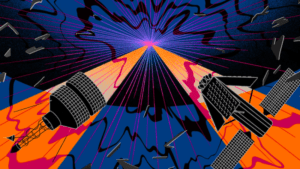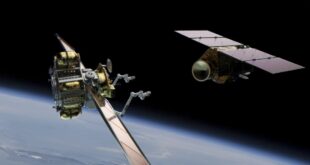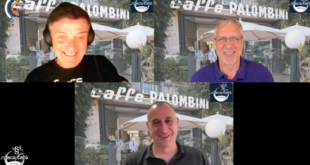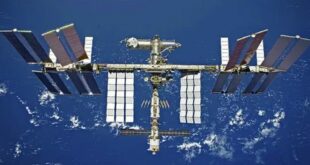
By Gabriella Skoff
Satellites have become critical tools in infrastructure and defence. They control GPS systems, enable international communications, allow us to watch the news “live” and track and relay information about the weather and other natural events. They facilitate business and financial communications, as well as radio and telephone capabilities. Satellites have become utterly vital to state infrastructures, making them fundamental assets for competing global powers. Now, we learn that new satellite constellations are being presented as the best way forward to empower a global quantum internet. As the use-value of satellites broadens and we become ever-more dependent on the networks and systems they support, two critical threats loom large. One, the physical threat of space debris; and two, the threat posed by the increasing militarization of space. These challenges to the implementation of a space-based quantum internet have not yet surfaced in the developing debate but must be addressed as we stand on the brink of the quantum age.
New research conducted by a Louisiana State University team led by Sumeet Khatri suggests that satellite-based technology is the best way forward to build a global quantum internet. According to the researchers, a quantum-enabled satellite constellation would be the most cost-effective approach to realise the next big application in quantum communications. Khatri’s team suggests that the most effective and logistically coherent system for a space-based quantum internet would require a constellation of at least 400 satellites, circling the globe in mid-Earth orbit, at an altitude of around 3,000 kilometres. On its own, 400 may not seem like a huge number of satellites, however, by way of comparison, GPS only needs 24 satellites to operate effectively. The nature of quantum entanglement—the essential property of non-locality utilized in quantum-satellite communications—is incredibly fragile, thus requiring a relatively high number of satellites and base stations to allow quantum information to travel without loss of signal.
Space Debris
Currently, there are around 2,000 active and 3,000 non-operational satellites orbiting Earth. Aside from these, National Geographic reports that there could be up to 500,000 pieces of what is known as space debris—man-made bits and pieces separated from rockets, space stations and satellites or simply left behind in space—littering Earth’s orbit. Space debris can vary in size, from a fleck of paint to an entire defunct satellite. It does not float idly through space, but rather, travels at a speed of about 17,500 miles per hour (approximately 28,163 km/h). At such great speeds, even a piece of debris as small as a pebble could cause serious damage in a collision with other Earth-orbiting objects such as space stations or satellites. As such, these collisions not only pose a risk to astronauts and space stations (powerfully depicted in the 2013 film, Gravity) but also to critical satellite-based communications infrastructures.
The challenge posed by space debris has not only made its way in popular culture but is heavily monitored by NASA, as a satellite and space-mission security issue. Today, NASA and the U.S. Department of Defence use ground-based telescopes and laser radars to monitor and report on the locations of more than 1,700 pieces of space debris in order to help prevent collisions with operating spacecraft and satellites. These efforts have so far proven sufficient—only a few collisions have occurred that have caused considerable damage to either spacecraft or satellites, but the potentiality for collision events is becoming increasingly common. At the same time, plans to launch more and more satellites are announced regularly by both state and non-state actors. While the situation is currently manageable, a predicted influx of over 50,000 satellites in orbit over the next decade would certainly tip the scales. A satellite-based quantum internet would, of course, add to this crowded milieu.
As a now poignant 1998 article, The Danger of Space Junk, for The Atlantic warned: “over time everything in Earth’s orbit will be ground into celestial scrap”, creating “a mausoleum of space technology”. Scientists now warn that if we do not manage existing space debris and ensure that future satellites and spacecraft are fitted with de-orbiting mechanisms, this reality will soon come to fruition. Most space-bound objects have no built-in function for de-orbiting and will continue to float (or rather, zoom) through the congested low- and mid-Earth orbit as they break into smaller and smaller fractions through degradation or collision with other orbiting objects. Each collision, no matter how small, exponentially compounds the problem.
This problem, which we are now beginning to witness, is known as the Kessler Syndrome. The eponymous Kessler Syndrome was posed by NASA’s Donald Kessler in 1978 in a co-authored quantitative study on the issue. The theory argues that the continued launching of satellites without a plan for de-orbit will lead to exponential collision frequency, creating a “debris belt” in low-Earth orbit that could render future space exploration and the use of satellites impossibly risky, creating a huge setback that could last generations. This leads to a concerning prognosis for the maintenance of entire space-borne infrastructures, which, among other critical functions, transmit national secrets and protect society from incoming natural and man-made disasters like hurricanes and missiles.
There are a variety of niche innovations underway that aim to confront this encroaching challenge, including Japan’s giant space whip (known as the electrodynamic tether, or EDT), which intends to swat debris out of earth’s orbit, causing it to incinerate as it falls toward Earth. The most effective technology for the job, however, is for future satellites to be built with a functionality to end their own lives once their tasks are complete, using their last bit of power to head back toward Earth where they will burn up in the atmosphere in order to self-decommission. This is currently a rapidly evolving space where new innovations are being applied and tested regularly. Projects like D-Orbit’s purpose-built, de-commissioning cubesat and the World Economic Forum’s 2019 project to create a space sustainability rating look hopeful. These types of conscious industry advances are necessary in order to ensure we avoid the Kessler Syndrome, so we can continue to use space sustainably to host novel satellite applications like a quantum internet.
Security
As we have reported on previously, space itself is no sanctuary from geopolitical rivalries. The implementation of a space-based global quantum internet will present a challenge for the grey area of international space development. Quantum satellites straddle the fine line between non-militarised and militarised infrastructure. Quantum technologies are heavily invested in by military-state apparatus—especially in China and the U.S. For either of these countries, the large-scale deployment of quantum-satellites could push us over that line and into an uncertain future of a highly militarised outer space. Already, U.S. President Donald Trump has initiated the development of a dedicated space arm in the U.S. defence forces with Space Force. In China too, the space and military programs are the same entity. Satellites are the centrepieces in both U.S. and Chinese space-security programs, both in offensive and defensive capacities. Recently, Russia, France and Norway have also invested heavily in satellites for a variety of security motivations.
While the conversation around space-military fusions sounds like the stuff of futurist, sci-fi fiction, it is very much a real and unfolding topic in the meta-geopolitical debate. Meta-geopolitics, untethered from traditional geographic constraints, refers to a new phase of international relations contextualised by the rise of border-defying security threats, like terrorism, cyber warfare and espionage, and global warming. It also extends to outer space, where our ever-growing dependence on satellite-based infrastructure is at increasing risk of interference and jamming by state or non-state actors.
China has been a demonstrated leader in both satellite-based quantum communications and offensive security since 2007, when the country tested its anti-satellite missile—a move that thrust satellites to the top of military agendas, especially in the U.S. In 2016, China launched Micius, the first quantum satellite that would soon facilitate ground-to-space quantum-secure communications across the globe. Since then, as we heard at last year’s Q Symposium from Jingyun Fan of China’s University of Science and Technology (watch his presentation here, from 1:10), China has been hard at work, refining the quantum communications capabilities of Micius. Aside from China and Europe, satellite-enabled quantum communications efforts are also underway in North America and the Indo-Pacific, including in Australia. The development of this new wave of satellite technology is only just beginning in earnest and promises to see more and more purpose-built quantum-satellites launched into earth’s low and middle-orbit in the coming years.
From a security perspective, achieving global quantum communications has long been a target, as it promises to enable hack-proof security for long-distance information transmission. While the achievements have so far been narrow, a space-based quantum internet is the next step in ensuring the tamper-proof transmission of vital information across the globe. It is easy to understand the benefit of these capabilities to any national or allied security apparatus. It is equally clear to see how the targeted destruction of quantum-satellites could become an immensely effective tactic in war. Enter space as a new “operational domain” of war, as recently declared by NATO in November of 2019. The inclusion of space as an operational domain acknowledges both the alliance’s critical reliance on satellite infrastructure and the growing threat posed by anti-satellite weaponry capabilities.
We are witnessing a rapid cluttering and securitization of outer space, a “frontier” that once seemed boundless, beyond human reach. Before state and non-state actors continue to dive head-long into this process, they should pause to consider the reality we are facing—a global, quantum space-based effort would put new pressure on an already saturated and precarious potential field of combat. Maintenance of the status quo will push the world into a grey area in both quantum and political science, where the path forward presents risks we are only just beginning to witness and understand. As our satellite capabilities expand and our tethered dependency on these orbital-objects grows, so too does the severity of the threat of their potential interference, blocking or destruction—by accident or by design.

Gabi Skoff is an impact-focused Researcher and Writer invested in bridging the gap between the social and the technical. Her work focuses on the intersection of emerging technologies and social sustainability, investigating the current and future social, political and ecological impacts of quantum and blockchain technologies. She works as a Content Developer for Project Q, Sydney and for Topl, a Houston-based ImpacTech startup. Gabi holds a Master of International Development from the University of Sydney and a Bachelor from New York University, where she specialised in International Relations and Sociology. Gabi has lived and worked in the United States, Argentina, Australia and the Netherlands. She is currently based in Sydney, Australia.
This article is republished with the permission of Project Q. The original version can be found here
Read more from this author on Medium here.
 SpaceWatch.Global An independent perspective on space
SpaceWatch.Global An independent perspective on space




